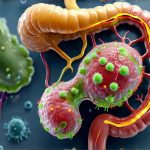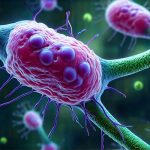Our bodies are remarkably adaptable systems, capable of weathering significant changes in diet and environment. However, this adaptability isn’t solely inherent within our own cells; it’s profoundly influenced by the trillions of microorganisms residing within us, collectively known as the gut microbiota. For decades, we considered these bacteria mere passengers, but now we understand they are active participants in nearly every physiological process, including how well we respond to shifts in what we eat or where we live. They aren’t just reacting to our choices; they are actively shaping our responses and even influencing our cravings, effectively acting as a buffer between us and external fluctuations.
The gut microbiota is not static – it’s a dynamic ecosystem that changes based on numerous factors: the food we consume, medications we take (particularly antibiotics), stress levels, geographic location, and even how we were born (vaginal birth versus C-section). This constant flux isn’t necessarily negative; in fact, it’s essential for maintaining health. A diverse and resilient microbiota is better equipped to handle perturbations, allowing us to navigate dietary changes or environmental stressors with greater ease. Understanding this dynamic relationship is key to optimizing our wellbeing and harnessing the power of these microscopic allies. You can learn more about how to balance gut bacteria through dietary adjustments.
The Gut Microbiota as a Dietary Mediator
The composition of your gut microbiome is heavily influenced by what you eat. Different bacterial species thrive on different substrates, meaning that changing your diet leads to changes in microbial populations. A diet rich in fiber, for example, promotes the growth of bacteria that ferment fiber into short-chain fatty acids (SCFAs) like butyrate, propionate, and acetate. These SCFAs aren’t just waste products; they are crucial signaling molecules with widespread effects on our health. They nourish colon cells, reduce inflammation, improve gut barrier function, and even influence brain function via the gut-brain axis. Conversely, a diet high in processed foods and sugar tends to favor less beneficial bacteria and can disrupt microbial balance—a state known as dysbiosis. It’s also important to consider how fermented foods might impact sensitive digestion.
This dynamic interplay means your gut microbiome isn’t just responding to your diet; it’s actively shaping your food preferences. Certain bacteria produce metabolites that influence our reward pathways, potentially driving cravings for specific foods. For example, some species may encourage consumption of sugary foods to fuel their own growth. This creates a feedback loop where dietary choices impact the microbiota, and the microbiota, in turn, influences those choices. It’s a complex system that highlights how intertwined we are with our gut microbes.
The ability of your gut bacteria to adapt to new food sources is remarkable. When you introduce a new food – say, a previously unencountered vegetable – initially, the bacteria best suited to digest it may be present in relatively low numbers. However, as they metabolize the compounds within that food, their population increases, and over time, your microbiome becomes better equipped to handle it. This is why gradual dietary changes are often more successful than drastic ones; it allows the microbiota to adapt without being overwhelmed.
Adapting to Increased Fiber Intake
Increasing fiber intake is a common goal for many seeking improved health, but doing so too quickly can lead to uncomfortable digestive symptoms like bloating and gas. This isn’t necessarily a sign that you shouldn’t increase fiber; it’s an indication your gut bacteria need time to adjust. The process of adaptation involves several key steps:
- Initial Discomfort: When you first introduce more fiber, the bacteria capable of fermenting it haven’t yet established sufficient populations. This leads to increased fermentation in the colon, producing gas as a byproduct and causing discomfort.
- Microbial Shift: As you continue consuming fiber, the bacterial species that thrive on it begin to proliferate. Simultaneously, other species may decrease in numbers as their preferred food sources are overshadowed.
- SCFA Production: With an increased population of fiber-fermenting bacteria, SCFA production rises. These SCFAs contribute to a healthier gut environment and improve digestive function.
- Reduced Symptoms & Improved Tolerance: Over time, the microbial shift leads to reduced gas production and improved tolerance, as your gut becomes more efficient at processing fiber.
Gradual increases in fiber intake, combined with adequate hydration, are crucial for minimizing discomfort during this adaptation process. Starting with small amounts of fiber-rich foods (like berries or oats) and slowly increasing portion sizes over several weeks allows the microbiota to adapt without being overwhelmed. Probiotic supplementation, while not a substitute for dietary changes, might also provide some support during this transition period by introducing beneficial bacteria that can aid in fiber fermentation. It’s helpful to evaluate gut response as you make these adjustments.
The Role of Microbial Metabolites in Adaptation
Beyond SCFAs, gut bacteria produce a wide array of metabolites – small molecules derived from the breakdown of food or host compounds – that play critical roles in adaptation. For instance, bile acid metabolism is significantly influenced by the microbiota. Bile acids, produced by the liver to aid in fat digestion, are modified by bacterial enzymes, altering their potency and absorption. This process impacts how effectively we digest fats and can influence cholesterol levels.
Another example is tryptophan metabolism. Tryptophan, an essential amino acid, is converted into various metabolites by gut bacteria, some of which (like serotonin) have profound effects on mood and sleep. The specific metabolites produced depend on the composition of your microbiota and dietary intake. A healthy microbiome ensures a balanced production of these metabolites, contributing to overall wellbeing.
The ability of the gut microbiota to detoxify harmful compounds is also crucial for adapting to environmental changes. Many environmental toxins are metabolized by bacteria in the gut, reducing their toxicity before they can be absorbed into the bloodstream. This detoxification capacity varies depending on microbial composition and highlights the protective role these microbes play in shielding us from external stressors. You may want to interpret gut testing to understand your microbiome’s capabilities better.
Microbiota Resilience & Environmental Changes
Our environment – including factors like geography, climate, and exposure to pollutants – also profoundly impacts our gut microbiota. Travel, for example, often leads to changes in diet and exposure to new microorganisms, disrupting microbial balance. This can result in “traveler’s diarrhea” or other digestive issues. However, a resilient microbiome is better able to withstand these disruptions and recover more quickly. Understanding gut sensations can also help you recognize when your gut needs support during travel or change.
Microbial diversity is a key determinant of resilience. A diverse microbiota has a wider range of metabolic capabilities, allowing it to adapt more effectively to changing conditions. It also provides redundancy – if one species declines due to environmental stress, others can step in and fulfill its function. Conversely, a less diverse microbiome is more vulnerable to disruption and may take longer to recover.
Building microbial resilience involves several strategies: – Maintaining a diet rich in fiber and plant-based foods – Avoiding unnecessary antibiotic use (which can indiscriminately kill both beneficial and harmful bacteria) – Managing stress levels (as chronic stress can negatively impact gut health) – Spending time in nature (exposure to diverse environmental microbes may promote diversity). Ultimately, understanding the interconnectedness between our gut microbiota, diet, and environment is crucial for optimizing our adaptability and overall wellbeing. If you are navigating these changes within a relationship, it’s helpful to handle a sensitive gut together. And if nausea arises, understanding whether it’s related to the gut or nerves is an important first step.


















